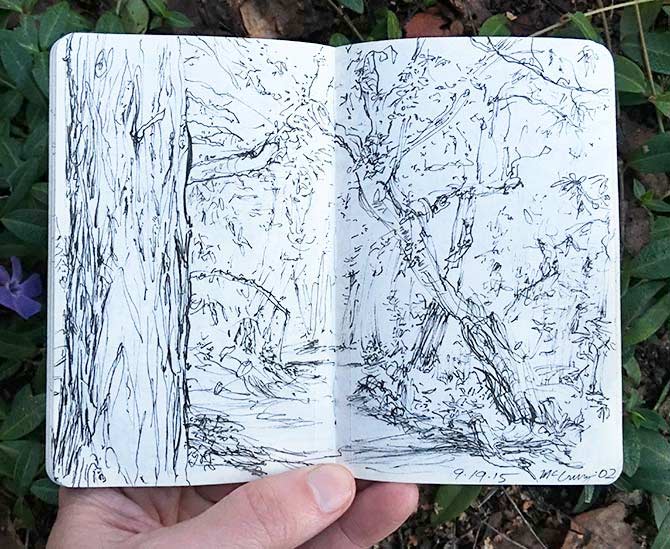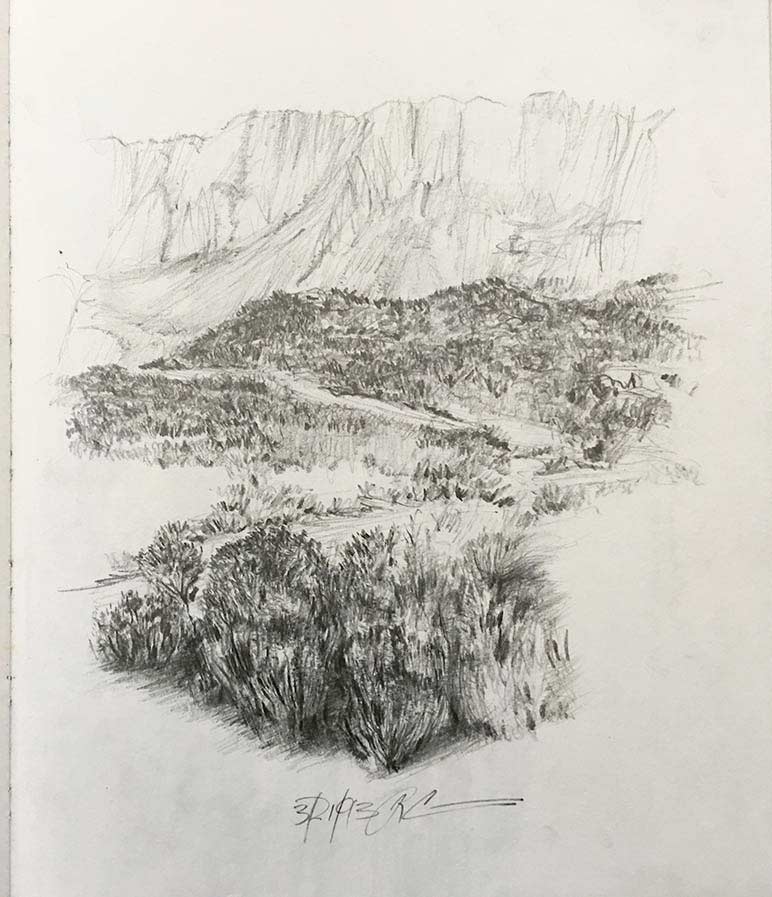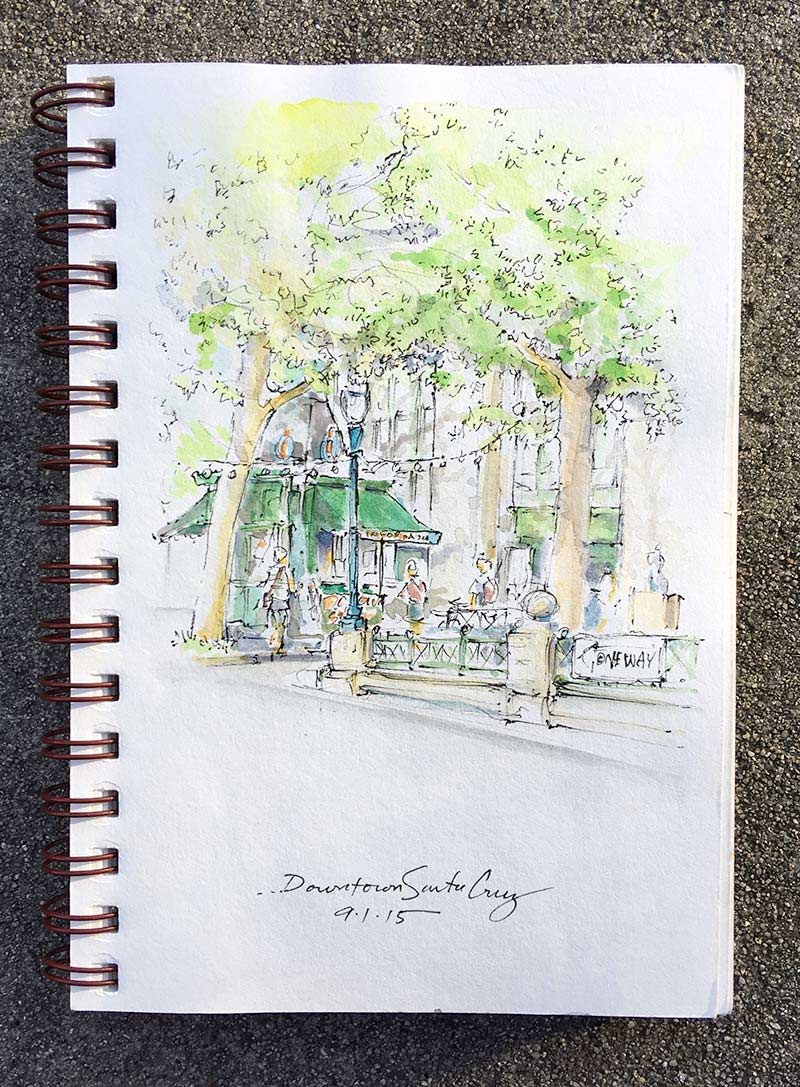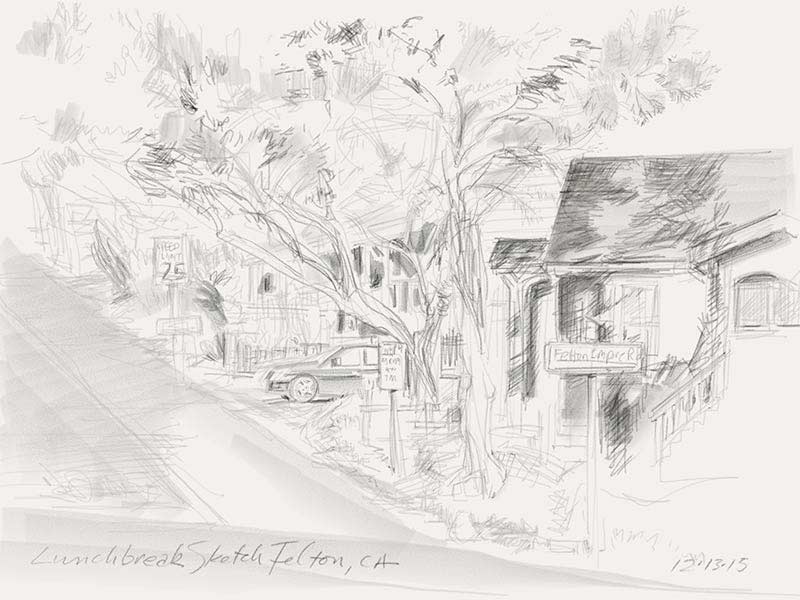
On urban streets or nature trails, where I enjoy sketching swiftly, I often find myself struggling with how to show realistic depth in my drawing. I’ve come up with a few strategies that use emphasis of lines and tones to create the illusion of depth and I’d like to share them with you.
In the Thick and Thin of the Forest
When riding my mountain bike, I carry a pocket-size sketchbook for doing studies of wooded areas on the trail. Depicting realistic depth in my drawings and dealing with the overwhelming amount of details are big challenges when drawing with Micron pens. In the sketch shown above, I practiced varying the thickness of lines and using a minimal amount of details to emphasize important elements in the composition.
For the larger tree trunk, to the left, notice how my line work slows down a bit to emphasize the texture of the bark. I used heavier, darker lines to emphasize the contour edges of the trunk and defined lines to suggest texture. This tree was nearest to where I was standing, and by emphasizing its details it became the foreground of my picture. This allowed me to create a midground and background for trees with thinner line work and less detail. I experimented with using thinner line work and fewer details to suggest trees that are farther away, receding to the background.
I like to keep a fast-paced rhythm while sketching fluid lines, often without lifting pen from paper. By adjusting pressure on the pen, and its angle to the paper, I’m able to control the sensitivity of thick and thin lines. This gives me the boldness or delicacy needed to emphasize elements in the sketch. For example, a few wispy lines in the above sketch suggest a meandering trail showing perspective and depth, allowing us to walk into it.
Light & Dark Values

The strategy of using emphasis also works well when sketching with pencils. In my larger sketchbooks I often use woodless graphite pencils. I’m able to hold the wonderfully smooth pencils sideways and quickly cover larger areas of the page to depict a wide range of tonal values. I did the above sketch in 1993 while living in Mexico. At the time, I was reveling in learning to apply pressure on the pencils for smoothing on lighter and darker values. I emphasized the chaparral in the foreground by using darker values and showing more details of the plants. As the landscape receded in the distance, I applied less pressure on the pencil and lightened tonal values showing foliage and a rocky ridge in the background. This is called atmospheric perspective and comes in handy for depicting depth in your drawing. I also used a form of linear perspective to show the winding dirt road getting narrower as it snaked up the hill in the distance.
Cityscapes, Washes, and Economy of Lines

I enjoy capturing the hustle, bustle, and character of Santa Cruz and other cities I visit. In urban sketching I’m also confronted with the challenges of depicting realistic depth in my drawing, not to mention the bombardment of details to choose from when deciding what is important to draw. Aside from sketching accurate angles of perspective, choosing what to emphasize was crucial to giving 3D depth to the sketch shown above. As in my trail sketches, I used darker lines and more details to emphasize the fence in the foreground and thinner lines for elements receding to the background such as trees and buildings. Since sketching swiftly is important to me, I use ink lines to emphasize just enough details showing the character and mood of the scene. The watercolor washes are left to show the background and spots of color that hold the composition together.
What to Leave In, What to Leave Out

What to emphasize in a drawing is often a matter of choosing what is important to you at the moment you are making it. If your intention is to spend an entire afternoon making a highly detailed watercolor sketch of a cityscape, what you choose to emphasize will be different than in a quick iPad digital study of a tree casting a shadow on a roof, like the one shown above. Emphasizing specific details that fascinate you in a drawing can be a valuable way of studying and note taking for future projects.
What you emphasize in a sketch can bring realistic depth and details to your work. But we can never forget what the most important emphasis of all is in our drawing. And that is the enjoyment we experience in making it.
Want to sketch with me? Got questions? Connect with me now!
Rob Court
Latest posts by Rob Court (see all)
- Drawing With Friends - April 11, 2022
- Frozen in Time: Cellphone Users as Models to Draw - April 8, 2022
- Getting Out & Getting Real - June 20, 2021
- Life Lines: Sketching the Unseen World of Movement - June 20, 2021
- The Ups & Downs of Urban Sketching - May 9, 2021